Nanoviews: StikkyTM Night Skies, Better than Well, and more . . .
By
Short takes on ten books
Short takes on ten books

DOI: 10.1511/2003.26.0
Learning the constellations normally requires a handbook and at least a few cloudless nights for practice. But the authors of StikkyTM Night Skies Night Skies (Laurence Holt Books, $12) have provided a way to engage in this pursuit even when the weather isn't ready to cooperate. They have published a simple guide to the heavens that actually shows the stars as they would appear overhead—that is, as so many points of light on a solid black background. The goals of the book are quite modest—teaching the reader how to identify Orion, the Big Dipper, Polaris and Cassiopeia, for example, constitutes one of the three learning sequences provided. So the book is suitable even for teaching preschoolers. The problem is that this introduction hinges on learning Orion, a winter constellation, which may not be up when the reader tries to apply the lessons learned to the real sky. (Something of a warning to summer readers is buried in the epilogue.) Also, the book uses a rather cumbersome construction involving a line from the zenith to convey the idea that Polaris indicates north. Despite these shortcomings, the book is attractive because it provides a handy planetarium-in-your-hand for youngsters who want to learn a few constellations and test their skills immediately.—D.A.S.
Philosopher and bioethicist Carl Elliott explores the modern American pursuit of happiness through "enhancement technologies" in Better than Well: American Medicine Meets the American Dream (Norton, $26.95). Science has provided us with the means—Prozac, Viagra, cosmetic surgery and sex-reassignment surgery—for "self-improvement," and Elliott wonders whether such physical and psychological enhancements are in fact more accurately described as changes in identity. For him "authenticity" serves as a moral ideal, and he suggests that there is a moral cost to partaking in these technologies. He writes about the "cruel logic" of our system: "In America your social status is tied to your self-presentation, and if your self-presentation fails, then your status drops. If your status drops, then so does your self-respect. Without self-respect, you cannot be truly fulfilled. If you are not fulfilled, you are not living a truly meaningful life." His take-home message is that there is something wrong with a culture that pushes its people so hard that they chemically and physically alter themselves to achieve an ideal self. Although others have delved into this subject before, Elliott's absorbing account will make readers think again about the ways that science shapes our personal identities.—M.S.
Physician Robert Buckman takes a look at the miniature beasts that inhabit our bodies in Human Wildlife: The Life That Lives On Us (Johns Hopkins University Press, cloth $49.95, paper $21.95). The next time you worry about the nature of self and your identity, consider this: Each of us is made up of roughly 100 trillion cells, but only 10 trillion of these are human cells. Most of the other 90 trillion are bacteria, with a few other parasites, fungi and miscellaneous critters also crawling around the human ecosystem.
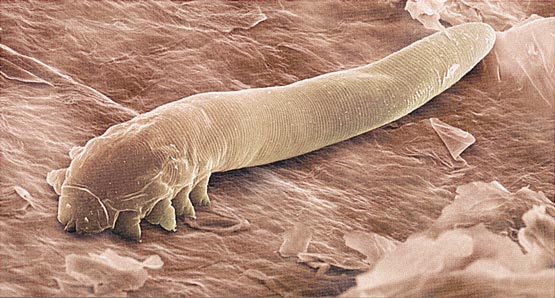
From Human Wildlife
This is a book that just about everyone will find in some measure fascinating, disturbing, engaging, repulsive and funny. My favorite section is the one on eyebrow mites, Demodex folliculorum (above), which burrow into our eyebrow follicles, leaving their rear ends wagging in the air (below).
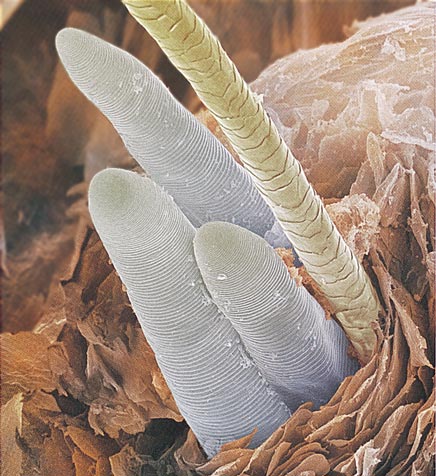
From Human Wildlife
Buckman's irrepressible, somewhat adolescent sense of humor permeates the book. For example, a chapter on fecal organisms is titled "The Origin of Feces," and a section called "The Art of the Fart" is illustrated with photos of Mylar pantaloons used to trap flatus for study. If this kind of stuff doesn't bother you, then there's plenty more that surely will. Buy it for a friend who worries about "germs."—M.S.
Death is inevitable, but it doesn't have to end a career. Mary Roach's Stiff: The Curious Lives of Human Cadavers (W. W. Norton, $23.95) breezily chronicles how, religion permitting, a person's biggest contributions to science may be made posthumously.
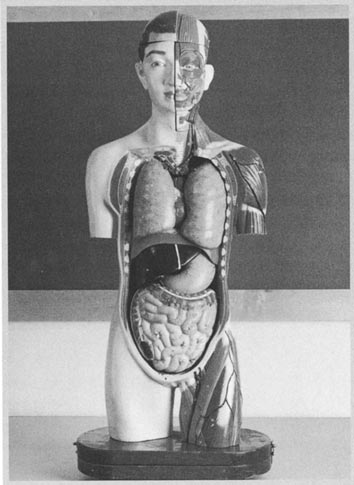
From Stiff: The Curious Lives of Human Cadavers
Roach, a science writer, animates her text with odd historical facts and engaging material gathered from interviews. She tackles a variety of topics, including the role of cadavers in medicine (where they are used for everything from organ transplants to heads for plastic surgeons to practice on) and in forensics (where they help to determine the causes of crimes and crashes). Even when discussing cannibalism and cremation, Roach exhibits both a keen sense of humor and a sincere respect for the dearly departed.
Stiff is a fun read that, despite its macabre topic, is surprisingly heartening. After all, it's reassuring to know that once one shuffles off this mortal coil, there's still plenty a body can do.—F.D.
MIT students apparently do some of their best work outside the classroom, under cover of darkness. Nightwork: A History of Hacks and Pranks at MIT (The MIT Press, $19.95), ostensibly authored by Institute Historian T. F. Peterson (IHTFP), is the third in a series of books detailing some of the students' more brilliant extracurricular activities. (It should be noted that hacks refers here to clever, benign practical jokes and not to computer hacking, which at MIT is called cracking.)

From Nightwork: A History of Hacks and Pranks at MIT
A prime campus target is the 150-foot-tall Great Dome: It has been transformed into the Star Wars droid R2-D2 (below) and has hosted a variety objects over the years, including a fiberglass cow, an operational phone booth and the shell of a Campus Police car—complete with flashing emergency lights, a dummy police officer with a box of doughnuts and a parking ticket noting "No permit for this location."
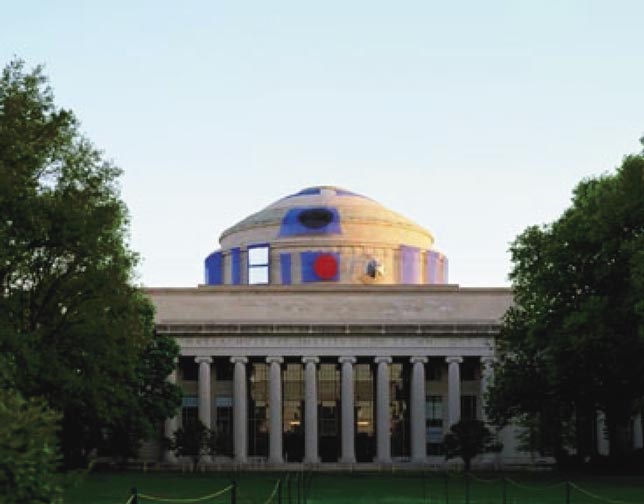
From Nightwork: A History of Hacks and Pranks at MIT
Unfortunately, Nightwork suffers from poor production values: Inexcusably, the dreary black and white transfers of photographs pulled from the collections of the MIT Museum lack captions. But the anecdotes about campus antics make the book worth a look.
For a full-color glimpse of some recent campus pranks, visit the school's "Interesting Hacks to Fascinate People" (IHTFP) Web site (http://hacks.mit.edu), created in collaboration with the museum. (And while you're there, be sure to check out the site's Frequently Asked Questions to discover the full significance of the acronym IHTFP.)—F.D.
Sesame Street is brought to us by the numbers 1 through 9, rather than the numbers I through IX, thanks to Leonardo Pisano, better known today as Fibonacci. Not that Leonardo invented the nine numerals, or the all-important zero; he gives the credit for that (and for much else) to Indian and Arab predecessors. But it was Leonardo's book Liber Abaci, completed 800 years ago in 1202, that spread the Hindu-Arabic scheme of arithmetic throughout Italy and then the rest of Europe.
Strange to report, Liber Abaci was never published in an English translation or in any other modern language. Even the Latin original has been hard to find outside the rare book room: The last edition was printed in 1857. But now this cornerstone of mathematical culture has finally become widely available with the appearance of Fibonacci's Liber Abaci: A Translation into Modern English of Leonardo Pisano's Book of Calculation (Springer, $99). The translator is Laurence E. Sigler of Bucknell University, who died before the book saw print; the final stages of publication were supervised by his widow—J. M. Sigler—and several colleagues.
What kind of math does an 800-year-old textbook teach? Leonardo begins with a primer on arithmetic, including methods for the fingers as well as for pen and paper, and after some 600 pages he gets as far as the algebra of linear and quadratic equations. The techniques are illustrated by hundreds of problems and solutions, most of them having to do with commerce: converting currency and units of measure, sharing profits, calculating interest. This is mathematics for the merchant class. But every now and then the student is allowed a moment of whimsy, as with the famous problem of breeding rabbits that gives us the sequence 1, 2, 3, 5, 8, 13 . . ., the Fibonacci numbers.—B.H.
One loves what one loves." The late Stephen Jay Gould offers this explanation for Triumph and Tragedy in Mudville: A Lifelong Passion for Baseball (W. W. Norton, $24.95), a collection of his writings on a subject that, like evolutionary biology, held his interest from childhood. Gould probes his (and our) fascination with one of the nation's favorite pastimes through a combination of reminiscence, social commentary and scientific inquiry. Included are personal reflections on the sport's importance for immigrants, boyhood reminiscences about the golden age of New York baseball, comments on the irony of a lifelong New York Yankees fan having Boston Red Sox season tickets, and probing profiles of baseball's "heroes." Famous Yankee players of Gould's youth play a prominent role, but so do commissioners, managers, broadcasters and fallen heroes such as the 1919 Chicago "Black" Sox.
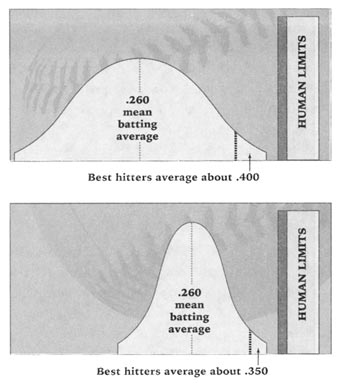
From Triumph and Tragedy in Mudville: A Lifelong Passion for Baseball
Gould is at his best when he uses his critical powers and statistical acumen to challenge speculation on the advantages of batting left-handed or to explain the disappearance of the .400 hitter as resulting paradoxically from play that has improved as far as human limitation will permit. The performance of average players has gotten better (bringing them closer to the wall of human limits), even though their batting average has not, because of pitching gains. And as the drawing below illustrates, variation has accordingly decreased strongly on both flanks.—T.G.
In The Seashell on the Mountaintop: A Story of Science, Sainthood, and the Humble Genius Who Discovered a New History of the Earth (Dutton, $23.95), Alan Cutler describes the life of 17th-century Danish scientist Nicholas Steno. A keen observer of the internal structures of animals and of the Earth, Steno was one of the first to amass substantial evidence that our planet has undergone drastic changes over its history and that those changes are recorded in layers of rocks and fossils. He was also a devout convert to Catholicism who in later life gave up his worldly possessions and served as a bishop in hostile, largely Protestant Northern Europe. He was beatified by the Church in 1988.
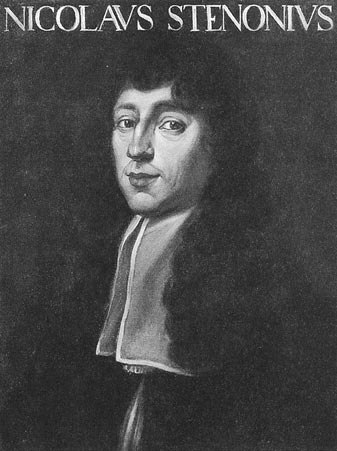
From The Seashell on the Mountaintop
Cutler's detailed depiction of Steno's development as a scientist and of his abandonment of that life to enter the priesthood is a compelling story about an unusually modest genius. Apparently Steno never considered his scientific views to be in conflict with his religious beliefs, and neither did his Catholic patrons and church elders. Despite his conclusion that seashells on mountaintops were not placed there by God or by Noah's flood, Steno maintained his allegiance to his Catholic faith. Indeed, Cutler argues that his rejection of literal readings of the Bible as they pertained to the origin of the Earth played a part in his decision to convert from Protestantism. But in the end, Steno's commitment to his new religion led him to neglect his scientific projects and his personal health, and the ultimate result was that he died a pauper at the age of 48, well before his revolutionary geological ideas were fully accepted.—M.P.
There is something in the human mind that loves a landscape. Maybe it's our ancestral memory of scanning the African veldt or perhaps some deep-seated need to see the big picture. Whatever the cause, a new book from the German Aerospace Center, Planet Earth (Alfred A. Knopf, $40), does a marvelous job of providing some geographic eye candy with 150 images of our world as seen by orbiting satellites. One almost feels envious of those mechanical eyes in space. It's a shame that most of us will see these landscapes only in a book.

From Planet Earth
Concentric sediments from a primeval ocean in the Mauritanian desert (above) are used by astronauts as a landmark.

From Planet Earth
Defensive earthworks and embankments along the border between Iraq and Iran (above) date to the war between those two countries in the 1980s.—M.S.
All the mind's a stage in The Bard on the Brain: Understanding the Mind Through the Art of Shakespeare and the Science of Brain Imagery (Dana Press, $35), in which Oxford University neurologist Paul M. Matthews and writer Jeffrey McQuain attempt to illustrate some of the recent progress in functional neural imaging by linking it to the human experience as described in the plays of Shakespeare. I enjoyed the book perhaps more for the wonderful performance images (mostly from The Shakespeare Theater in Washington, D.C.) than for the often-tenuous connections it makes between art and science.
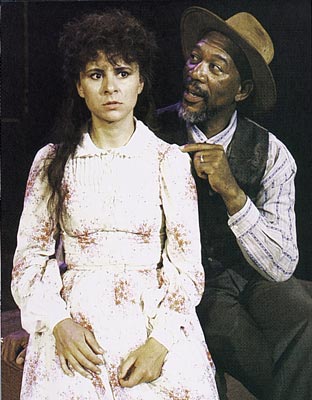
From The Bard on the Brain
The material falls into a predictable pattern: The authors quote a passage of Elizabethan verse, illustrate it with some stage shots and then describe a (sometimes marginally) related imaging study. For example, in the "Battle of the Sexes" section of the "Decision and Action" chapter, Matthews and McQuain excerpt from The Taming of the Shrew some repartee between Katharina and Petruchio (shown above as portrayed by Tracey Ullman and Morgan Freeman), observe that the idea that men are from Mars and women from Venus is not new, and then launch into a description of research that found that men and women differed in the rate and accuracy with which they solved a spatial problem. The shift from the poetry of Shakespeare to the language of science can be jarring. Fortunately, the science is geared for a general audience. The book works well as an entertaining primer on functional brain imaging.—C.B.
Nanoviewers: Chris Brodie, Frank Diller, Tom Good, Brian Hayes, Margaret Pizer, David A. Schneider, Michael Szpir
Click "American Scientist" to access home page
American Scientist Comments and Discussion
To discuss our articles or comment on them, please share them and tag American Scientist on social media platforms. Here are links to our profiles on Twitter, Facebook, and LinkedIn.
If we re-share your post, we will moderate comments/discussion following our comments policy.